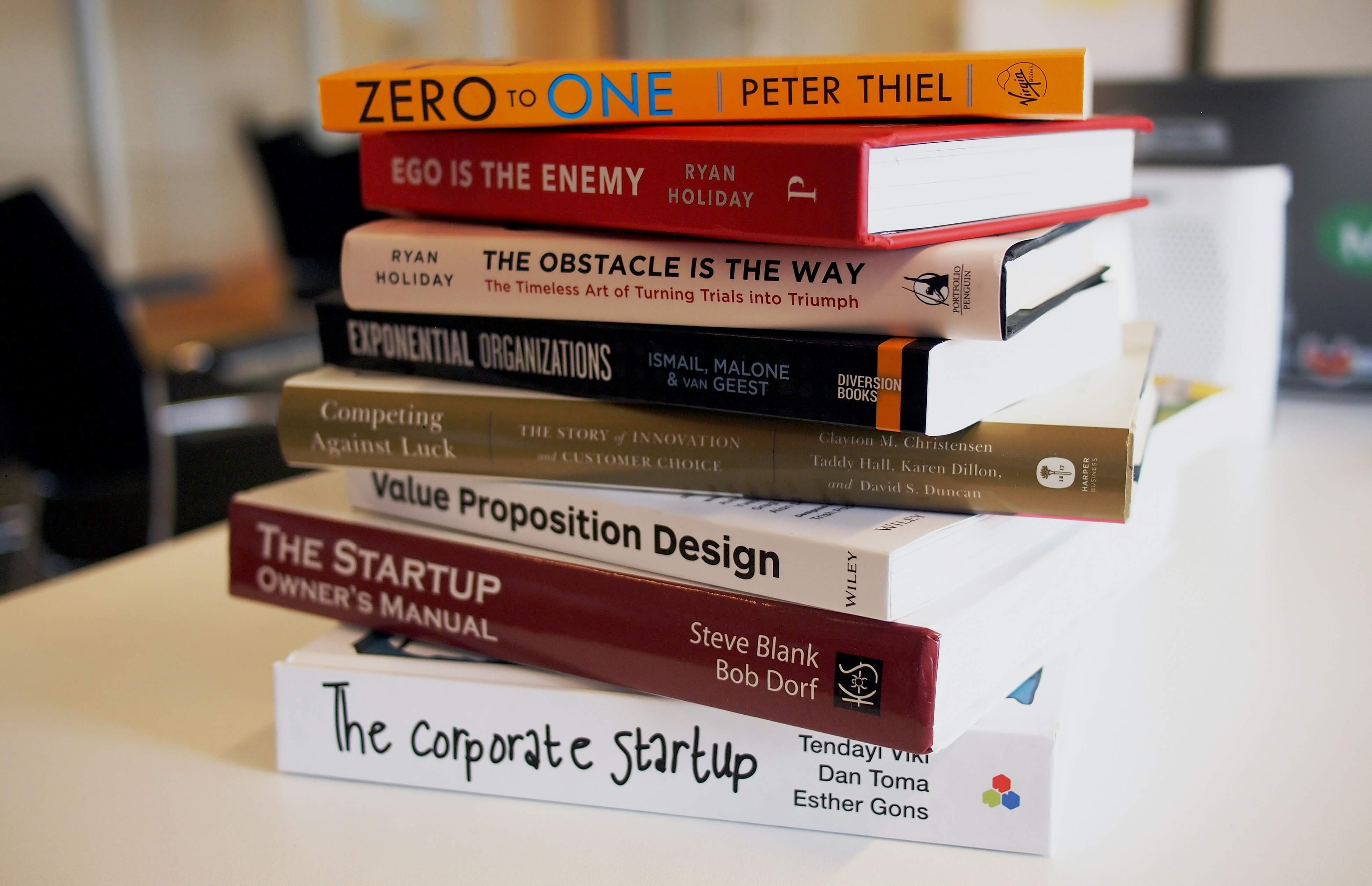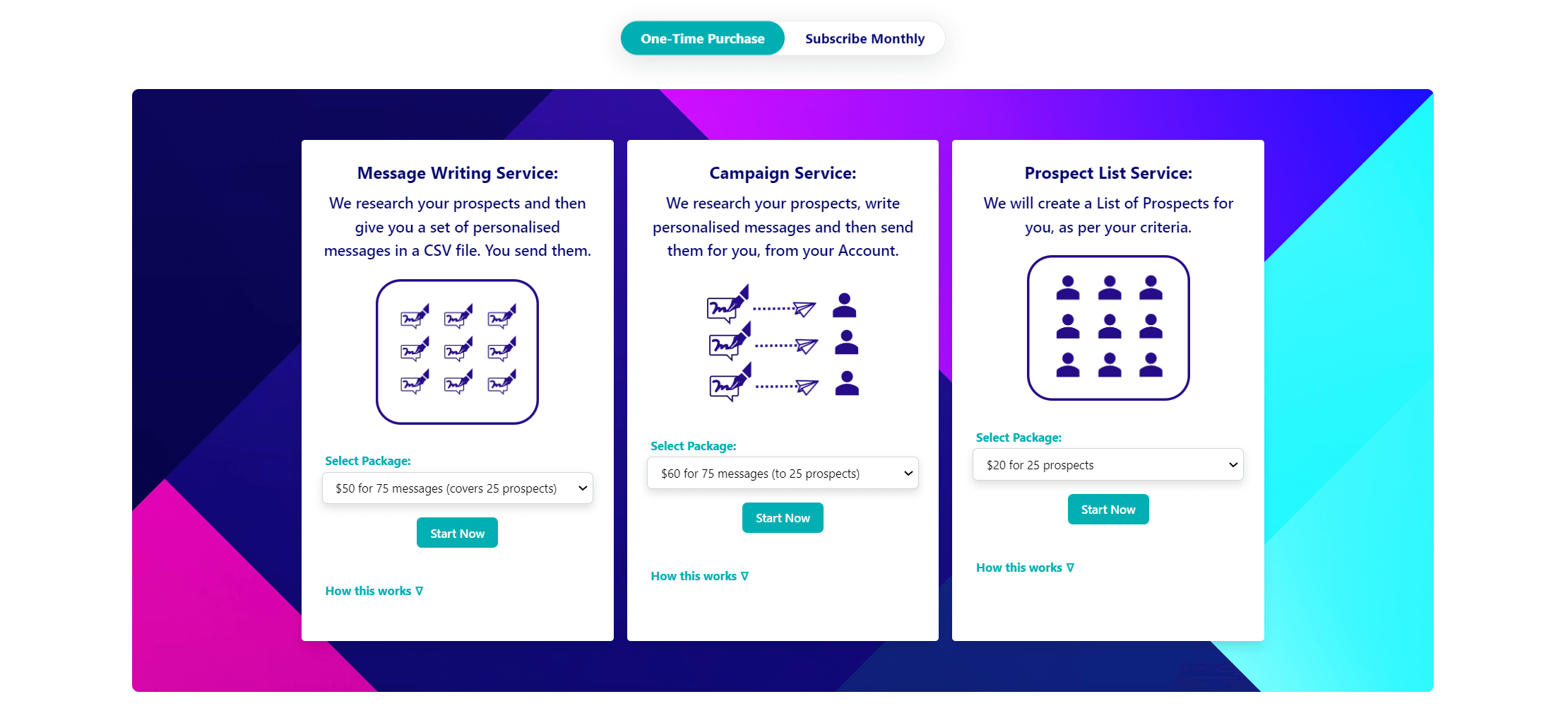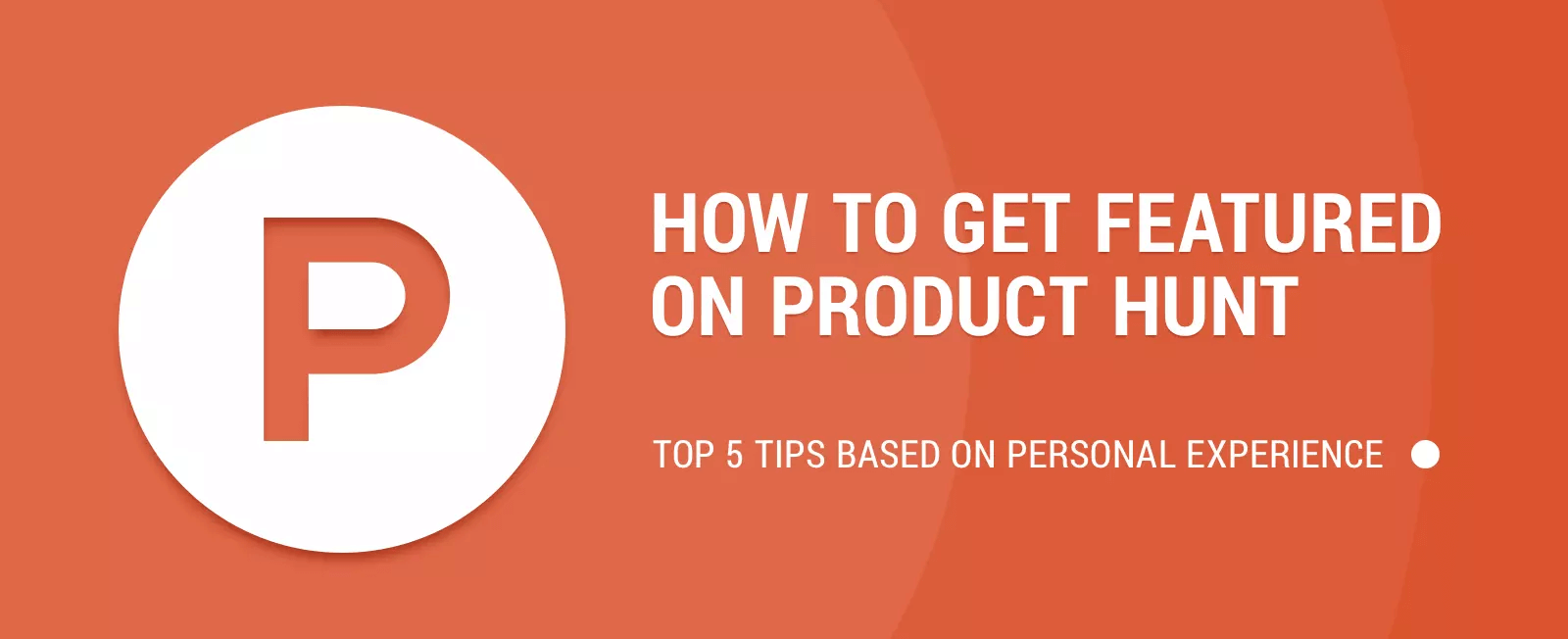Is AI sophisticated enough yet to create authentic and convincing cold outreach?

Testing Open AI's ChatGPT3.5
First thing's first - it's no secret that anyone can now use ChatGPT to generate text. So why not use it to construct cold outreach messages? That would be handy wouldn't it! Noone would ever have to write an outreach message again...
So can the basic version of ChatGPT generate outreach messages that are good enough? We weren't convinced that the results would be high enough quality. So we gave it a go.
We chose an example scenario. We assumed we'd just connected with someone on LinkedIn and we wanted to send a first outreach message. We gave ChatGPT that context and asked it to construct that message for us.
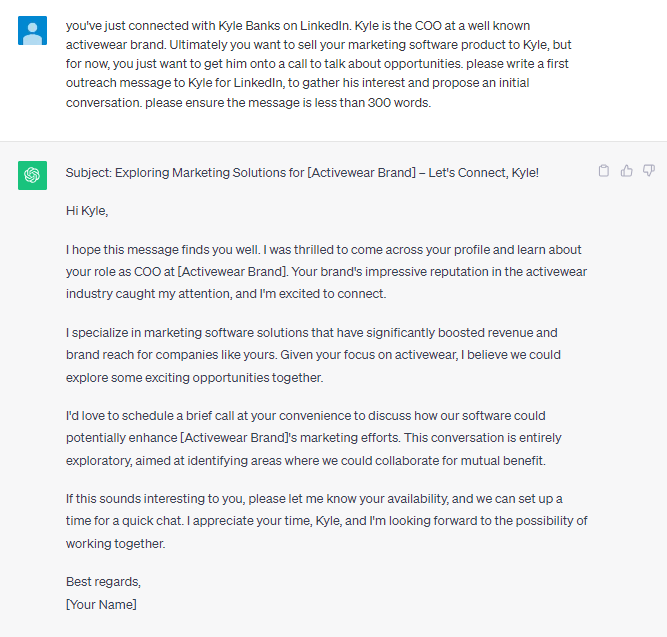
Hmmmm, here are our thoughts on the results:
-
Words like 'thrilled', 'impressive', 'excited' are a little over-the-top - we'd never choose those words and they set an awkward tone. The message seems inauthentic and it's easy to guess it's been produced automatically.
-
Most of the content is very generalised or unspecific - like 'I specialize in marketing software solutions that have significantly boosted revenue and brand reach', or like 'our software could potentially enhance your marketing efforts', or like 'we could collaborate for mutual benefit'. These words are taking up precious real estate and will lose the attention of the recipient - we didn't even ask for them!
Testing Open AI's ChatGPT4
So, we thought, perhaps ChatGPT 4 would be better - because it has much more advanced reasoning. We gave it the exact same prompt, to keep things consistent and make a comparison possible. Here's the result:
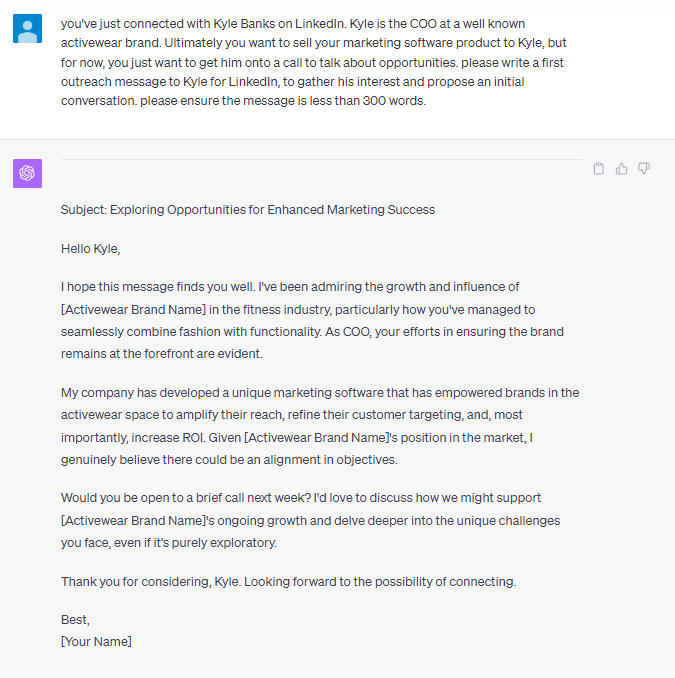
Hmm, now we have some new problems:
-
The response has made some assumptions and created some 'truths' that are not actually true. Like: 'particularly how you've managed to seamlessly combine fashion with functionality'. What does that even mean?!
-
The response lists similar generic benefits, which don't add anything, given most tools would claim to deliver them: 'amplify their reach', 'refine their customer targeting', 'increase ROI'.
At least the message is generally very polite and professional. But it is still very inauthentic.
Testing Google's Bard
Another option is Bard - which is Google's eqvuivalent of ChatGPT. So we figured we should give it the same prompt as a test. Here is what it returned:
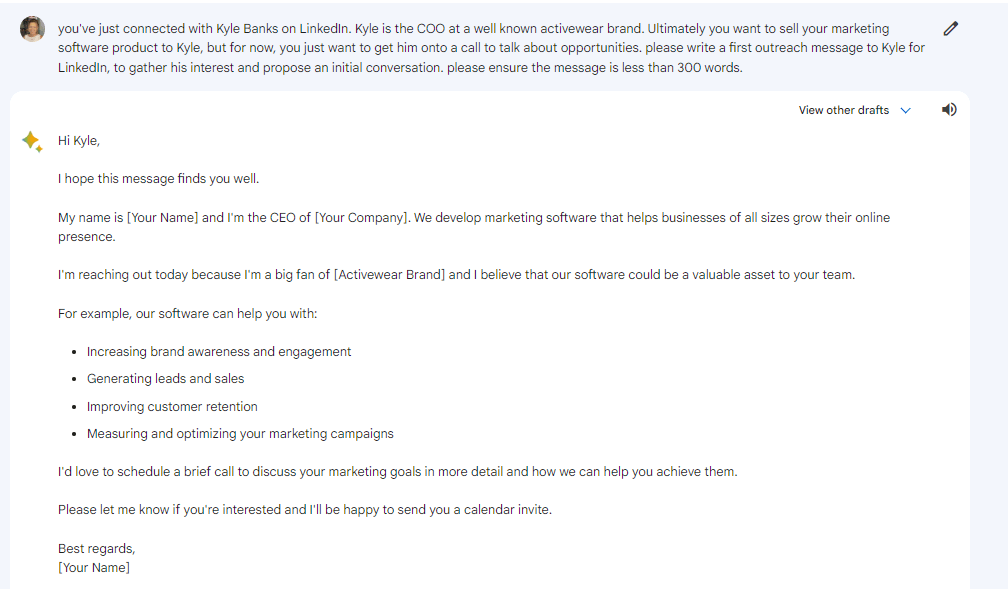
Interestingly this response is much more focused on talking about the proposition, and much less interested in referencing anything about Kyle, the prospect, or his company.
But again, Bard has manufactured 'truths' about the product and its benefits - all of which are too generic or unspecific. And some of which may not even apply to the product.
Unreliability like this makes it impossible to use and trust these publicly available generative AI tools at scale for outreach.
Testing the Open AI API - with the same prompt
Once we knew that publicly available tools wouldn't support the use case easily, we decided to try using Open AI's APIs instead. Using the APIs gives us more flexibility - because we're able to engineer the prompt more specifically, as well as potentially fine-tune the engine for our needs.
So first of all, let's send the same prompt through to Open AI's APIs, just to test what kind of response it returns - and whether it's the same as is returned for ChatGPT.
Here is the prompt, in API request form:

And here is the response the API sends back:
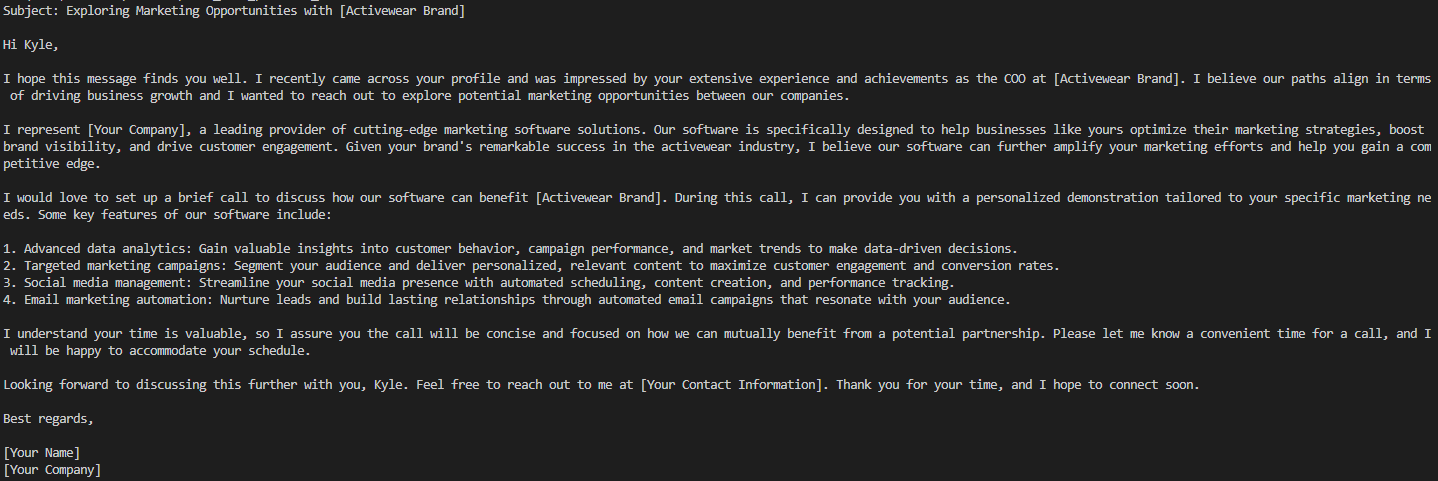
With exactly the same prompt as we gave ChatGPT, the response from Open AI's GPT API is more detailed, and on the surface, quite good.
But there are still very obvious tells that this is an AI-generated message:
-
The word 'impressed' is used again (although the language is less over-the-top in general).
-
The message still contains very generic business phrases like 'optimize marketing strategies, boost brand visibilty, drive customer engagement'.
-
Again there are 'truths' being constructed from nowhere - does the tool even have the 4 features listed? We've not told GPT anywhere that it does, so it's pulling this information from its generic training dataset - and that training dataset knows nothing about our tool and its features.
Turning to consider general format and substance of the message, there are a couple of other things that feel wrong too:
-
There is nothing mentioned that is specific to Kyle - the message references his 'experience and achievements as COO' but doesn't mention any specific achievement - and so could come across as hollow.
-
The benefits conveyed as the reason Kyle's company would specifically benefit from this proposition are also too generic: 'amplify your marketing efforts and help you gain a competitive edge'. Literally any tool in the marketing space could say this.
So whilst this GPT response is an improvement on ChatGPT's response, it is still very inauthentic. And in addition, we're starting to see that we need to provide a lot more context to ensure that false 'truths' are not constructed, and the required level of specificity can be achieved.
Enhancing the Open AI API prompt - with some context of a recent LinkedIn article
So with the learnings above, we decided we'd try adding some more personal and topical information on Kyle to the prompt. This is the approach most LinkedIn outreach automation tools are currently taking - they scrape prospect information and activity from LinkedIn and use that data to personalise messages for each prospect.
Specifically for this test, we chose to tell GPT that Kyle had recently posted a LinkedIn article about the importance of employee engagement.
The test here is whether GPT is able to draw a relevant and compelling link between an article whose topic (employee engagement) is unrelated to the (marketing software) product being sold. It's a tough test, but it's realistic. At any point in time, Kyle may have posted something that does not relate specifically to the product being sold.
Here is our prompt. Note the additional assistant role line which talks about Kyle's article:

And here is the response:
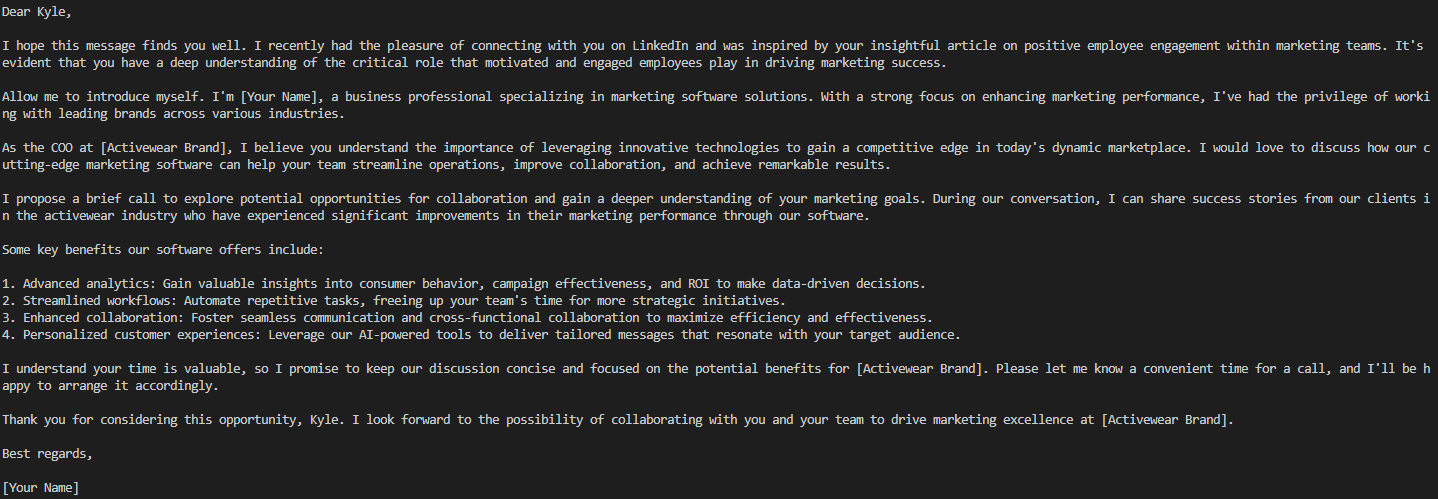
The response includes a nice reference to the article Kyle posted - which may well attract his attention more than the previous response.
But the message quickly then moves on to write in a very similar way as previously. No real connection is drawn between the article and why that is a reason to reach out - other than, possibly, the 'marketing' link, which is tenuous. The lack of logical thread from the start of the message through into the meat of the message will likely lose Kyle's attention. It quickly becomes a sales pitch with no direct and specific relevance to him.
It's also worth noting that this message repeats exactly the same text as the previous response. So the lack of variety of wording could create circumstances where recipients become savvy to identifying which messages were generated by AI. Especially if multiple outreach automation tools are taking this approach.
So, without a logical thread, and with the same AI-tells as the previous message, this iteration unfortunately remains as inauthentic as the previous.
Enhancing the Open AI API prompt - with still more context, this time on the tool being sold
One thing we hadn't done yet was give GPT enough information about the tool being sold. How is it going to be able to identify a very compelling reason to reach out to Kyle if it doesn't know enough about the context - i.e. the product being sold?
Perhaps with some information about the product, GPT would be able to draw appropriate links between that and Kyle's posted article.
So in our final test, we tried explaining to GPT a little about the product being sold: this is software that automatically drives engagement on LinkedIn.
Here is the prompt (notice the additional assistant line):

And here is the response:

Well, we had higher hopes for this response, but our hopes were dashed! Here's the list of problems with this response:
-
The message still contains very generic info about the product: 'we specialize in providing innovative marketing software solutions to help business optimise their strategies and achieve outstnaidng results' - this type of wording is still too vague and generalised.
-
GPT has really missed the point in its explanation for the reason for reaching out. Article engagement (i.e. the purpose of the product being sold) has nothing to do with employee wellbeing, but GPT is suggesting that it might. Ultimately, illogical statements will likely confuse Kyle and he will disengage.
-
The end of the message is exactly the same as the end of the previous message - which introduces risk that this message will be identifiable as AI-generated, especially if other people are approaching Kyle using similar automation techniques.
Despite the negatives, there was one positive to note: GPT is no longer making up the 4 points about what the tool does - because we've given it some more specific information about the tool. That's a good learning for future prompt engineering!
So whilst progress was made in the quality of the response, by adding more specific information to the prompt, there are still some setbacks that make the message seem inauthentic.
Clearly, GPT needs much more sophisticated prompt engineering if it to produce authentic, compelling outreach messages.
Koneksi exists precisely to solve this challenge.
Authentic, compelling outreach requires much more than the above.
Authentic, compelling outreach can be generated by GPT only with very very careful training and prompting. And only with very very intricate information. And all of that has to happen at scale, for hundreds of thousands of prospects.
That's the challenge we're solving at Koneksi. We are the only ones that know how to do it.
Here's a message Koneksi stands behind:
"Hi Kyle,
Your recent LinkedIn article about employee engagement really resonated with me. I hope more people get the chance to enjoy reading your perspective. Increasing reach on LinkedIn is always tough though!
My company could support you in doing that next time. [Company] is software that helps LinkedIn users increase reach with appropriate audiences. We'd love to have a conversation if you have time this week?
Thanks,
[Name]"
Achieving something like this takes a lot. That's why we're focused on it 100%. And how are we achieving it? Well, if we told you that, we'd be giving away our secret sauce.

